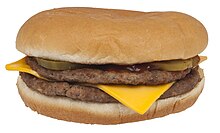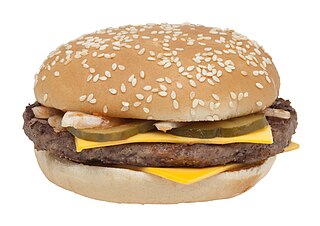
A hamburger, or better known as a burger, is a food consisting of fillings—usually a patty of ground meat, typically beef—placed inside a sliced bun or bread roll. Hamburgers are often served with cheese, lettuce, tomato, onion, pickles, bacon, or chilis; condiments such as ketchup, mustard, mayonnaise, relish, or a "special sauce", often a variation of Thousand Island dressing; and are frequently placed on sesame seed buns. A hamburger patty topped with cheese is called a cheeseburger.
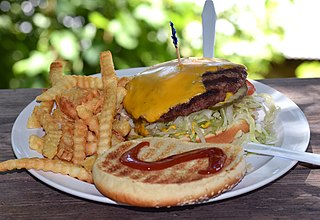
A cheeseburger is a hamburger with a slice of melted cheese on top of the meat patty, added near the end of the cooking time. Cheeseburgers can include variations in structure, ingredients and composition. As with other hamburgers, a cheeseburger may include various condiments and other toppings such as lettuce, tomato, onion, pickles, bacon, avocado, mushrooms, mayonnaise, ketchup, and mustard.
Ground beef, minced beef or beef mince is beef that has been finely chopped with a knife, meat grinder, mincer or mincing machine. It is used in many recipes including hamburgers, bolognese sauce, meatloaf, meatballs, and kofta.
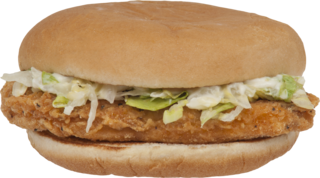
The McChicken is a chicken sandwich sold by the international fast food restaurant McDonald's. In some countries, such as Australia, Fiji, India, New Zealand, and the UK, it is considered to be a chicken burger, especially given it is not a sandwich as that word is understood in some of those non-American varieties of English. It consists of a toasted wheat bun, a breaded patty, shredded lettuce and mayonnaise.
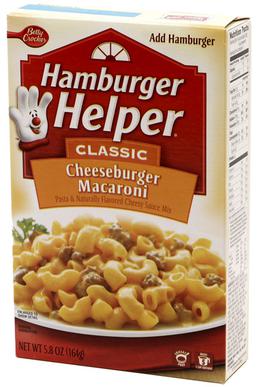
Hamburger Helper is a packaged food product manufactured by Eagle Foods. As boxed, it consists of a dried carbohydrate, with powdered seasonings contained in a packet. The consumer is meant to combine the contents of the box with browned ground beef ("hamburger"), water, and, with some varieties, milk to create a complete one-dish meal.

The Quarter Pounder is a hamburger sold by international fast food chain McDonald's, so named for containing a patty with a precooked weight of four ounces (113.4 g), or one quarter of a pound. It was introduced in 1971. In 2013, the Quarter Pounder was expanded to represent a whole line of hamburgers that replaced the company's discontinued Angus hamburger. In 2015, McDonald's increased the precooked weight to 4.25 oz (120 g).

The Big King sandwich is one of the major hamburger products sold by the international fast-food restaurant chain Burger King, and was part of its menu for more than twenty years. As of March 2019, it is sold in the United States under its 1997 Big King XL formulation. During its testing phase in 1996–1997, it was originally called the Double Supreme and was configured similarly to the McDonald's Big Mac—including a three-piece roll. It was later reformulated as a more standard double burger during the latter part of product testing in 1997. It was given its current name when the product was formally introduced in September 1997, but maintained the more conventional double cheeseburger format.

A&W is a fast-food restaurant chain in Canada, franchised by A&W Food Services of Canada, Inc.

The Burger King Specialty Sandwiches are a line of sandwiches developed by the international fast-food restaurant chain Burger King in 1978 and introduced in 1979 as part of a new product line designed to expand Burger King's menu with more sophisticated, adult oriented fare beyond hamburgers. Additionally, the new line was intended to differentiate the company from other fast food hamburger restaurants at the time. Since the line's introduction, the other sandwiches have been discontinued, leaving the chicken offering, the Original Chicken Sandwich, as the primary product left. Additionally, other sandwiches that utilize the same roll as the chicken sandwich have been introduced to the company's menu both domestically and internationally since the original product line was introduced.
McDonald's Corporation is the world's largest chain of fast food restaurants, serving around 68 million customers daily in 119 countries. McDonald's traces its origins to a 1940 restaurant in San Bernardino, California. After expanding within the United States, McDonald's became an international corporation in 1967, when it opened a location in Richmond, British Columbia, Canada. By the end of the 1970s, McDonald's restaurants existed in five of the Earth's seven continents; an African location came in 1992 in Casablanca, Morocco.

McDonald's Israel is the Israeli master franchise of the fast food restaurant chain McDonald's. Operated and licensed by Alonyal Limited, McDonald's Israel is the largest of Israel's burger chains with a 60% market share. It was the first Israeli outlet to be opened in 1993 and a major competitor of the local restaurant chain Burger Ranch. The world's first kosher McDonald's was opened in Mevaseret Zion in October 1995.
A hamburger is a specific type of burger. It is a sandwich that consists of a cooked ground beef meat patty, placed between halves of a sliced bun. Hamburgers are often served with various condiments, such as dill relish (condiment), mayonnaise, and other options including lettuce, tomato, onion, pickles, and cheese.
Beef Products Inc. (BPI) is an American meat processing company based in Dakota Dunes, South Dakota. Prior to high media visibility of its products, it was a major supplier to fast food chains, groceries and school lunch programs. It had three additional plants, which closed in 2012.

Evidence suggests that either the United States or Germany was the first country where two slices of bread and a ground beef patty were combined into a "hamburger sandwich" and sold. There is some controversy over the origin of the hamburger because its two basic ingredients, bread and beef, had been prepared and consumed separately for many years in both countries before their combination. Shortly after its creation, the hamburger quickly included all of its currently typically characteristic trimmings, including onions, lettuce, and sliced pickles.

The Big N’ Tasty is a hamburger sold by the international fast food chain McDonald's. It is designed to compete with the Whopper sandwich. A similar variation called the Big Tasty, without the center "N'", which was first released in Saudi Arabia, is sold outside the United States in parts of Europe, South America, South Africa, The Middle East, and Taiwan.

Lean finely textured beef is a meat by-product used as a food additive to ground beef and beef-based processed meats, as a filler, or to reduce the overall fat content of ground beef. As part of the production process, heat and centrifuges remove the fat from the meat in beef trimmings. The resulting paste, without the fat, is exposed to ammonia gas or citric acid to kill bacteria. In 2001, the United States Department of Agriculture (USDA) approved the product for limited human consumption. The product, when prepared using ammonia gas, is banned for human consumption in the European Union and Canada.
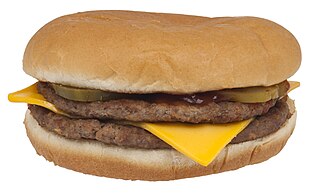
The McDouble is a hamburger sold by the fast-food restaurant chain McDonald's. It is a variation on the double cheeseburger, with only one slice of cheese placed between the two beef patties. It was introduced in 1997. It is one of the cheapest products sold by the company, and for this reason is often included in the chain's budget menus.
